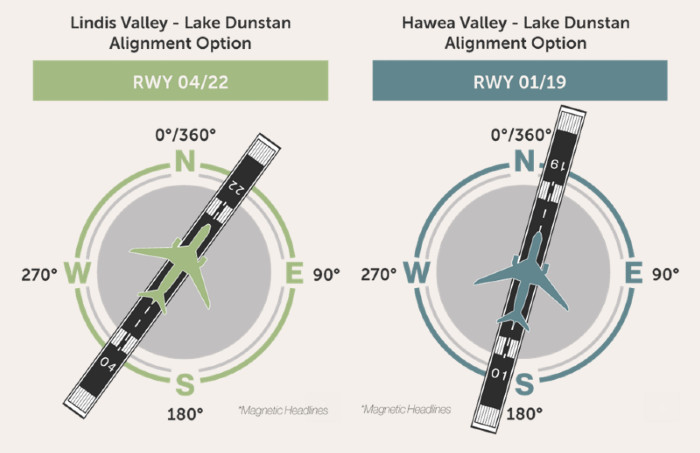Tarras airport could accommodate international flights
Rowan Schindler
23 September 2021, 12:00 PM
 Christchurch Airport Ltd has provided an update on their Tarras Airport development.
Christchurch Airport Ltd has provided an update on their Tarras Airport development. The preliminary aeronautical assessment for the Tarras Airport has been carried out, with prospective runways related to Cromwell and Tarras.
Christchurch International Airport Ltd (CIAL) revealed plans to develop a jet-capable airport on 750ha of land at Tarras in July 2020.
CIAL Tarras Airport Project Director Michael Singleton says the organisation is “committed to sharing what we learn as we explore the potential for a new airport to serve Central Otago”.
The assessment was undertaken with aviation consultancy Airbiz with the support of technical specialists.
The key finding is that the site is able to support an airfield with a single runway of at least 2.2 kilometres, although more detailed analysis is required.
Project Director Michael Singleton says the preliminary assessment is simply a small step forward for the project.
“The findings are encouraging but they’re not final. This assessment has given us the confidence to undertake the next stage of more detailed analysis to determine a preferred single runway alignment.”
The assessment identifies two potential runway alignments – one aligning to the Lindis Valley and Lake Dunstan, the other to the Hawea Valley and Lake Dunstan.
“This initial assessment shows both options enable safe and efficient operation of various aircraft types, including new generation narrow and widebody jets, freight, turboprop and small passenger aircraft.”
The site could enable a longer runway of up to 3km but more analysis is needed to confirm this.
“A single 2.2km runway would be able to serve all of New Zealand’s domestic routes and some short-haul international destinations such as Australia and parts of the Pacific,” says Michael Singleton.
“In general, a longer runway creates more opportunity for the region it serves because it enables businesses and people to connect with more destinations. Our job is to think long-term and identify what opportunities this site could deliver well into the future,” says Michael Singleton.
The preliminary assessment also found both alignments enable aircraft to connect to existing flightpaths and have similar emissions profiles.
“Assessing carbon performance is important. Sustainability is embedded into the way Christchurch Airport operates and any new airport would have to demonstrate how it fits in New Zealand’s low-carbon future to get the required planning and operating approvals,” says Michael Singleton.
“The assessment shows the site is suitable for the latest navigation and airfield technology which improve safety and fuel economy and reduce emissions.”
Noise impacts are yet to be technically analysed in detail, but the assessment contains illustrative noise profiles from a single aircraft movement on both alignments.
“While the lighter population of the area may lower the overall impact, we are committed to identifying and finding solutions,” says Michael Singleton.

One runway – two potential alignments
What’s next?
In an email update to subscribers, the organisation states the project is in the Planning and Validation phase gathering a wide plethora of information, the organisation states.
“The next phase of technical analysis will focus on more detailed assessments of flight paths, airspace integration, aircraft performance, wind shear, environmental performance and noise impacts.
“In addition, we have to establish how to design an airport that would secure the necessary approvals and warrant the level of investment required to create it.
“We’re also working with the MetService to develop a weather station which will gather site-specific data.
“Once our multiple workstreams are completed, we will be able to make an informed decision on whether to take the project into the next phase – getting the required operational and planning approvals.
“At this stage, we expect that decision will be made in 2023.”
As well as assessing impacts, the next phase of airspace analysis will be aimed at validating and refining the outcomes of the preliminary assessment. This will take between 6 and 9 months at which time the airport expects to be able to identify its preferred runway alignment.
Michael Singleton says the project’s Planning and Validation phase is expected to run to 2023.
“We have a number of interconnected and complex studies to undertake during this phase. It won’t be until they’re completed that we can make a decision on whether to take the project into the next phase – getting the required operational and planning approvals. In the meantime, we will continue sharing what we learn with those interested in the project.”
Details of the preliminary aeronautical assessment can be downloaded from the project’s website: www.centralotagoairport.co.nz


